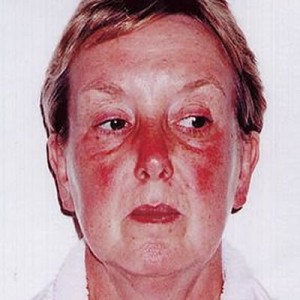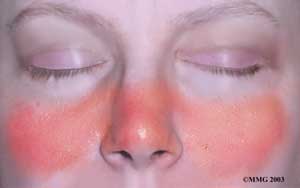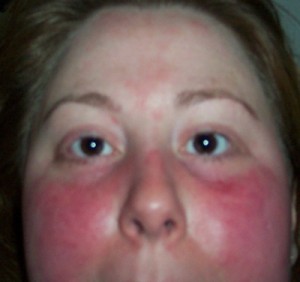Suffering from abnormal red or purple rashes o your nose or cheeks? You may be having Malar Rash, a common skin condition affecting many people across the world.
Malar Rash Description
Page Contents
What is Malar Rash? It is basically a skin condition mainly affecting the facial region of a person, especially the cheeks. The word “malar” comes from the Latin word “mala” meaning “cheek bone”. It is mostly characterized by the appearance of rashes on the cheek.
Malar Rash is also known by the name “Butterfly Rash”.
What does a Malar Rash look like?

Picture 1 – Malar Rash
Source – wikinut
A Malar Rash is usually reddish or purple in color. You can also find these eruptions having a mild scaly appearance. In a few cases, these are slightly discolored. These are normally shaped like a butterfly which gives them the name “Butterfly Rash”.
What does a Malar Rash feel like?
In classic cases of butterfly rash, the affected person does not experience any pain or itchiness. But the swelling can cause some discomfort and the sufferer may feel as if he has something taped to the cheek.
Does Malar Rash burn?
In some cases, one may find the Malar Rash hot to touch. In such situations, you will not only find the Malar Rash warm to touch but also suffer from problems like pain and itchiness in the affected area.
What causes Malar Rash?
A number of factors can work as Malar Rash causes. Some of the most notable causes of Malar Rash are :
Lupus
Systemic Lupus Erythematosus (SLE) is a chronic disease affecting the connective tissue of skin or joints. It leads to a swelling of the collagen protein in the connective tissue, which is seen from the outside as skin rashes. In most patients of Malar Rash lupus is found to be the causative agent. In 45-65% of patients with SLE Malar Rash is noted.
Dermatomyositis
This inflammatory condition leads to abnormalities in the skin and muscle and is one of the prime reasons behind the appearance of Malar Rashes.
Bloom Syndrome
Bloom Syndrome can also be one of the Malar Rash triggers. This abnormal disorder affects chromosomal arrangement in a person, resulting in many abnormalities which show as rashes on the epidermal layer.
Rosacea
In many sufferers of Malar Rash rosacea is a prime condition. This chronic skin disease gives rise to red rashes not only on the cheeks but also in other facial regions like forehead and nose. One can often find Malar Rash on Rosacea patients.
Seborrheic Dermatitis
This chronic skin condition (Seborrheic Dermatitis) results in rashes on the scalp, eyelids and other skin regions including facial area.
Erysipelas
This is an infectious condition brought about by the Streptococcal bacteria and results in acute skin inflammation. Red, painful rashes appear on the skin as a result.
Sunlight
Rashes may also appear if the skin is sensitive to sunlight. Malar Rashes are common in people with sensitive skin.
Malar Rash Symptoms
Butterfly shaped rashes are the most visible symptom of Malar Rash in Lupus. These rashes are mostly found on the bridge of the nose and also across the cheek. While Malar Rash (butterfly rash) on face is most common, one may also find Malar Rash on forehead. In a few cases there can be Malar Rash on neck.
Some of the accompanying symptoms of Malar Rash are :
Fatigue
The patient may also suffer from tiredness due to this condition. It is not fully clear why the disease gives rise to fatigue in sufferers.
Pain
The person may suffer from pain and stiffness or swelling in joints if there is lupus involved. Lupus adversely impacts the connective tissue of skin and joints which is the reason for pain in these regions.
Inflammation of Glands
Many patients are seen to suffer from swelling in the glands. This happens if the disease arises due to lupus.
Kidney Infections
Malar Rashes may be accompanied with kidney and urinary tract infection. There may be pain in the kidney which is one of the lupus Malar Rash symptoms.
Fever
An affected person may also suffer from higher body temperatures because of this condition.
Neurological Disorders
The disease often affects the central nervous system (CNS) and the person may suffer from nervous conditions like seizures, convulsion and confusion.
Malar Rash Diagnosis
An experienced physician starts the diagnosis after a proper physical examination of the rashes in the patient. This is followed by medical tests to aid an appropriate detection. The common tests used for the diagnosis of Malar Rash include examinations like ESR (Erythrocyte Sedimentation Rate) test, C-reaction protein test, X-rays and anti-nuclear antibody test.
Doctors also make a proper evaluation of the patient’s medical history. Urine tests, such as kidney biopsies, and blood examinations are also necessary in some cases for an accurate diagnosis.
Malar Rash Differential Diagnosis
Malar Rashes are similar to rashes appearing in Type 1 diabetes, Type 2 diabetes and Psoriasis. Blood tests are necessary to rule out the presence of such conditions.
Malar Rash Treatment
Malar Rashes can be treated in various ways. Some of the most common ways to cure Malar Rashes are :
Steroid Creams
Steroid based creams can be very helpful in curing inflammation and itching in the affected area.
Sunscreen
People with a sensitive skin should always take sunscreen protection before going out into the sunlight.
Healthy Diet
People with low immunity are often susceptible to Malar rashes. A healthy diet can boost the immune system and cure rashes. This is important for long term lupus Malar Rash treatment.
Sleep
Adequate rest is highly necessary for proper functioning of the body. You should always try to get enough sleep to keep all diseases at bay.
Water
Water helps flush toxins out of the body. Drinking enough water helps maintain hormonal balance and clear the bloodstream of all impurities.
Medications
If the cause of Malar Rash is some kidney disease, oral drugs are generally used for treatment. Doctors usually decide on a treatment depending on the extent of the causative disease.
How long does a Malar Rash Last?
How long does Malar Rash last? If you are suffering from these rashes, this may be what you are thinking. Malar Rashes usually take a week or longer to go away. With topical application, lifestyle modification and sunscreen protection, Malar Rashes normally disappear completely within a month.
Acute Malar Rashes may last for months and leave scars even after complete treatment.
Malar Rash Pictures
Not sure how Malar Rashes look like? Check out this Malar Rash photos. These Malar Rash images will help you get an idea about the appearance of these rashes. If you want to see butterfly rashes, these lupus Malar Rash pictures will help you.

Picture 2 – Butterfly Rash
Source – wordpress

Picture 3 – Malar Rash (Butterfly Rash) Picture
Source – cure4lupus
Malar Rashes are not serious, but they may be itchy and quite painful in a few cases. As they appear mostly on the face, they cause much embarrassment to the sufferer. If you see Malar Rash in children or adults in your family, it is important to carry out treatment as fast as possible and recover quickly from this disease.
References:
http://en.wikipedia.org/wiki/Malar_rash
http://www.wisegeek.com/what-are-the-symptoms-of-lupus.htm
http://www.wrongdiagnosis.com/sym/malar_rash.htm
http://kidshealth.org/teen/diseases_conditions/bones/lupus.html
http://emedicine.medscape.com/article/1065292-overview
http://www.wisegeek.com/what-is-a-lupus-malar-rash.htm
